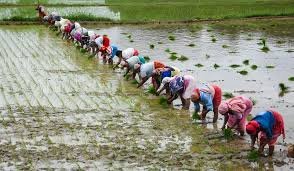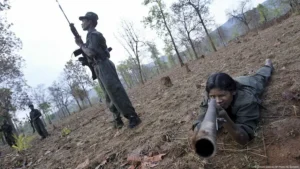1. Commission for Air Quality Management in NCR and Adjoining Areas (CAQM) – Polity

Why in News?
The Commission for Air Quality Management (CAQM) has intensified its efforts to tackle stubble burning, a key contributor to winter air pollution in the National Capital Region (NCR), especially with the onset of the paddy harvesting season in northern India.
About the Commission for Air Quality Management (CAQM)
Statutory Backing
Established under: Commission for Air Quality Management in National Capital Region and Adjoining Areas Act, 2021
Nature: Statutory Body
Jurisdiction: Covers Delhi and parts of Haryana, Punjab, Rajasthan, and Uttar Pradesh.
Purpose and Mandate
To ensure better coordination among various states for effective air quality management in the NCR.
To provide a unified approach to prevent, monitor, and control air pollution.
Key Functions
Coordinate actions across multiple state governments and central agencies.
Monitor air quality and recommend measures.
Research and provide policy inputs on environmental pollution.
Create a framework of action for the reduction of pollution sources, especially seasonal factors like stubble burning.
Powers of CAQM
Can restrict polluting activities such as construction, industrial emissions, vehicular pollution, etc.
Conducts inspections and research related to air quality.
Has the authority to issue binding directions, similar to those of a civil court.
Its directions are legally enforceable and binding on all stakeholders.
Reports to the Parliament.
Composition of CAQM
| Role | Details |
|---|---|
| Chairperson | Senior official (rank of Secretary/Chief Secretary), 3-year term or till 70 years |
| Ex-officio members | 5 members from state governments |
| Technical experts | 3 full-time members + experts from CPCB, ISRO, and NITI Aayog |
| NGO representation | 3 representatives from environmental NGOs |
Contextual Relevance: Stubble Burning
Stubble burning in Punjab and Haryana is a seasonal issue that worsens Delhi-NCR’s air quality during October-November.
Despite past Supreme Court and NGT interventions, the lack of coordination between states and enforcement challenges necessitated a centralized body—leading to CAQM’s creation.
Exam Connect – Possible Questions
Prelims
1. The Commission for Air Quality Management in National Capital Region and Adjoining Areas is:
A. A constitutional body
B. A statutory body
C. An executive agency
D. A judicial body
Answer: B. A statutory body
2. Which of the following organizations is NOT represented in CAQM?
A. Central Pollution Control Board (CPCB)
B. Indian Space Research Organisation (ISRO)
C. NITI Aayog
D. National Green Tribunal (NGT)
Answer: D. National Green Tribunal (NGT)
Mains
1. “The establishment of the Commission for Air Quality Management (CAQM) reflects the need for centralized environmental governance in India.” Discuss the need, mandate, and challenges faced by CAQM in fulfilling its role.
2. Stubble burning continues to affect air quality in Northern India despite various interventions. Analyze the effectiveness of CAQM in tackling this issue and suggest long-term solutions.
2. Sir Creek Border Dispute: India-Pakistan Tensions – International Relations
Why in News?
The Union Defence Minister of India recently issued a stern warning to Pakistan against any potential misadventures in the Sir Creek area, reiterating India’s commitment to protecting its territorial sovereignty and maritime boundaries.
About Sir Creek
| Feature | Details |
|---|---|
| Type | Tidal estuary |
| Length | ~96 km |
| Location | Forms part of the border between Gujarat (India) and Sindh (Pakistan) |
| Opens into | Arabian Sea |
| Terrain | Marshy, saline mudflats; ecologically sensitive area and habitat for migratory birds |
| Economic Significance | Rich fishing grounds, potential hydrocarbon resources, and implications for maritime boundaries under UNCLOS |
Historical Background of the Dispute
1908 – Origin of Dispute
Conflict between Ruler of Kutch (India) and Sindh Government (then under British India) over fishing rights and boundary demarcation.
1914 – Resolution by Bombay Government
Applied the Thalweg Principle: Boundary should follow the deepest channel of the river/creek (India supports this).
Partial resolution but left room for interpretational differences.
1965 – India-Pakistan War & Rann of Kutch Dispute
Sir Creek was indirectly affected during the broader Rann of Kutch conflict.
1968 – Tribunal Award
India got 90% of the Rann, but Sir Creek remained unresolved and became a separate bilateral issue.
Post-1982 – UNCLOS (United Nations Convention on the Law of the Sea)
With the concept of Exclusive Economic Zones (EEZs), control over Sir Creek now impacts maritime rights, including:
Fishing zones
Mineral/oil exploration rights
Strategic naval positioning
India’s Position on Sir Creek
Navigability Claim: Sir Creek is navigable during high tide, hence the Thalweg Principle should apply—giving India more maritime territory.
Legal Documents Cited:
1925 Resolution,
1819 Treaty, and other colonial-era records favor India.
Geographical Standpoint:
India argues the Rann is land, not water—so median division (which Pakistan demands) doesn’t apply.
Pakistan’s Position
Claims Sir Creek as a non-navigable water body, and hence demands the boundary to be drawn from the eastern bank, which would expand its maritime EEZ.
Rejects the Thalweg principle in this context.
Strategic & Geopolitical Significance
Control over Sir Creek impacts maritime security, naval access, surveillance, and resource rights.
In the broader South Asian context, the dispute reflects enduring India–Pakistan tensions, affecting:
Fishermen’s arrests
Border skirmishes
Bilateral negotiations and trust-building
Exam Connect – Possible Questions
Prelims
1. Sir Creek, a disputed estuary between India and Pakistan, opens into which of the following?
A. Gulf of Kutch
B. Arabian Sea
C. Bay of Bengal
D. Gulf of Mannar
Answer: B. Arabian Sea
2. Which principle is central to India’s claim in the Sir Creek dispute?
A. Median Line Principle
B. Uti Possidetis Juris
C. Thalweg Principle
D. Mare Clausum Principle
Answer: C. Thalweg Principle
Mains
1. Examine the historical and legal foundations of the Sir Creek dispute between India and Pakistan. How does the issue impact India’s maritime claims and security in the Arabian Sea?
2.“Post-colonial border disputes in South Asia reflect deeper geopolitical tensions.” Discuss in the context of the Sir Creek and Rann of Kutch disputes.
3. Govt Identifies 100 Aspirational Agriculture Districts (AADs) – Economy

Why in News?
The Union Government has announced the identification of 100 Aspirational Agriculture Districts (AADs) under the Prime Minister Dhan-Dhaanya Krishi Yojana (PMDDKY), aimed at enhancing farm productivity, promoting climate-resilient agriculture, and boosting rural incomes.
Key Takeaways
100 districts have been selected across 29 States and UTs.
Focus is on districts with:
Low agricultural productivity
Moderate cropping intensity
Limited access to credit and market linkages
Leading participating states:
Uttar Pradesh, Maharashtra, Madhya Pradesh, Rajasthan, Bihar
What are Aspirational Agriculture Districts (AADs)?
| Feature | Details |
|---|---|
| Definition | Low-performing agricultural districts selected for intensive development under PMDDKY |
| Purpose | To transform these regions into high-productivity and climate-resilient agricultural hubs |
| Planning Tool | Each district will prepare a District Agriculture Development Plan (DADP) integrating multiple schemes |
| Monitoring Mechanism | Performance will be tracked using a result-based index with clear, measurable outcomes |
About Prime Minister Dhan-Dhaanya Krishi Yojana (PMDDKY)
| Aspect | Details |
|---|---|
| Launched | July 2025 |
| Duration | 6 years (2025–2031) |
| Budget | ₹24,000 crore annually through convergence of 36 existing schemes from 11 ministries/departments |
| Beneficiaries | Estimated to benefit 1.7 crore farmers |
| Monitoring | 100 Central Nodal Officers to oversee implementation |
Objectives of PMDDKY
Increase farm productivity using modern technologies (e.g., precision farming, mechanization)
Promote climate-resilient agriculture and sustainable practices
Expand irrigation coverage and improve water use efficiency
Enhance agricultural credit and institutional finance access
Strengthen market linkages, value chains, and agri-infrastructure
Contribute to “Viksit Bharat 2047” vision by transforming rural livelihoods
Implementation Strategy
Convergence approach: Utilizes existing resources and schemes (e.g., PM-KISAN, PMFBY, PMKSY)
Localisation: District-level planning through DADPs
Decentralized Monitoring: Real-time evaluation using performance metrics (yield, credit flow, irrigation expansion, etc.)
Capacity Building: Farmer training programs on technology use and market access
Exam Connect – Possible Questions
Prelims
1. The Aspirational Agriculture Districts (AADs) are selected primarily based on:
A. Literacy rate and HDI
B. Per capita income and forest cover
C. Low agricultural productivity and limited credit access
D. Urbanization rate and demographic growth
Answer: C. Low agricultural productivity and limited credit access
2. Which of the following is NOT an objective of the PM Dhan-Dhaanya Krishi Yojana?
A. Boosting agricultural exports
B. Promoting climate-resilient agriculture
C. Increasing irrigation coverage
D. Enhancing credit access to farmers
Answer: A. Boosting agricultural exports
Mains
1. Discuss the key objectives and implementation strategy of the Prime Minister Dhan-Dhaanya Krishi Yojana. How will the identification of Aspirational Agriculture Districts contribute to sustainable rural development?
2. “Transforming agriculture at the district level is essential for achieving inclusive growth.” Analyze the role of convergence and decentralised planning in the success of schemes like PMDDKY.
4. Govt Mandates Sound Alert Devices for EVs to Enhance Road Safety – Science and Technology

Why in News?
The Ministry of Road Transport and Highways (MoRTH) has announced new regulations mandating the use of Acoustic Vehicle Alerting Systems (AVAS) in electric vehicles (EVs). This measure aims to improve road safety, especially for pedestrians and cyclists, by compensating for the low noise levels of EVs at slow speeds.
Key Takeaways
Implementation Timeline:
New EV models must have AVAS from October 1, 2026.
Existing EV models must comply by October 1, 2027.
Targeted Vehicles:
Applies to electric cars, buses, and trucks.
Excludes two- and three-wheelers for now.
Safety Concern:
EVs at low speeds (<20 km/h) produce almost no sound, making them difficult for pedestrians and other road users to detect—especially in urban areas.
What is an Acoustic Vehicle Alerting System (AVAS)?
| Feature | Description |
|---|---|
| Purpose | Emits sound to alert nearby pedestrians and cyclists of the EV’s presence |
| Activation | Works when the vehicle is: • Moving between 0–20 km/h • Reversing |
| Sound Mechanism | ses an external speaker to produce a continuous sound, either: • Mimicking an internal combustion engine, or • Using a unique synthetic sound |
| Speed-Based Control | Sound changes in pitch and volume based on speed, through connection with the vehicle’s Electronic Control Unit (ECU) |
| Automatic Deactivation | Turns off automatically above 20 km/h as vehicle noise becomes naturally audible |
Background: Rise of EVs in India
| Year | EV Share in Total Vehicle Sales |
|---|---|
| 2014-15 | 0.01% |
| 2024-25 | 7.31% |
| EVs Sold in 2024 | 19.5 lakh |
Urban Impact: The rapid adoption of EVs in cities and towns makes AVAS critical for pedestrian-heavy areas, school zones, and residential neighborhoods.
Gap in Regulation:
Two- and three-wheelers are not yet covered, raising concerns for crowded urban environments where they are prevalent.
Exam Connect – Possible Questions
Prelims
1. The Acoustic Vehicle Alerting System (AVAS) is required to be installed in which of the following vehicles as per recent MoRTH guidelines?
A. Only electric two-wheelers
B. All internal combustion engine vehicles
C. Electric cars, buses, and trucks
D. All hybrid and electric two- and three-wheelers
Answer: C. Electric cars, buses, and trucks
2. At what speed does the AVAS system typically deactivate in an electric vehicle?
A. 10 km/h
B. 20 km/h
C. 30 km/h
D. 40 km/h
Answer: B. 20 km/h
Mains
1. “While electric vehicles offer environmental benefits, they also pose new challenges to road safety.” Discuss how the implementation of AVAS reflects the balance between innovation and regulation in India’s transport policy.
2. “Technological mandates such as AVAS are essential to ensuring inclusive mobility.” Evaluate the effectiveness of government regulations in enhancing pedestrian safety in the context of EV adoption.
5. Clean Slate Doctrine under the Insolvency and Bankruptcy Code (IBC) – Polity

Why in News?
The Delhi High Court has reaffirmed the “Clean Slate Doctrine” under the Insolvency and Bankruptcy Code (IBC), holding that a successful resolution applicant is not liable for criminal or financial liabilities incurred by the previous management of a corporate debtor.
This ruling clarifies the legal immunity provided to new owners post-resolution and strengthens India’s insolvency framework.
Key Takeaways
The Clean Slate Doctrine allows a company to emerge from insolvency free of past liabilities.
Reinforced by Supreme Court judgments to support corporate restructuring and investor confidence.
Protects new management from legacy legal complications and encourages participation in resolution processes.
What is the Clean Slate Doctrine?
| Aspect | Details |
|---|---|
| Definition | A legal principle that ensures once a resolution plan is approved by the NCLT, the corporate debtor’s past debts and liabilities are extinguished. |
| Objective | To allow the revival of stressed companies without carrying forward legal baggage, giving them a “clean slate”. |
| Legal Backing | Part of the IBC, 2016, and reinforced through multiple Supreme Court decisions. |
| Scope | Applies to financial, operational, tax-related, and even certain criminal liabilities, unless included in the resolution plan. |
Key Judicial Precedents
Essar Steel India Ltd. Case (2019) – SC
Held that all liabilities, including government dues, are extinguished if not part of the approved resolution plan.
Edelweiss Asset Reconstruction Co. Ltd. v. Tax Authorities
Supreme Court ruled that government claims not mentioned in the resolution plan are invalid post-NCLT approval.
Surya Exim Ltd. Case – Delhi HC
Reiterated that any tax demands raised after the NCLT’s approval of the resolution plan should be canceled.
Significance of the Doctrine
Encourages bidders and investors to take over insolvent companies without fear of past liabilities.
Supports economic revival and ease of doing business in India.
Ensures that resolution applicants are not unfairly penalized for acts of previous management.
Boosts confidence in India’s insolvency regime, making it more efficient and globally competitive.
Exam Connect – Possible Questions
Prelims
1. The “Clean Slate Doctrine” is primarily associated with:
A. Environmental law
B. Criminal justice reform
C. Corporate insolvency and resolution process
D. Electoral reforms
Answer: C. Corporate insolvency and resolution process
2. In the context of IBC, which of the following statements is true?
A. Past liabilities of a company are automatically carried over to the new owner post-resolution.
B. Government dues must be settled separately even after NCLT approval.
C. Only criminal liabilities are extinguished, not financial ones.
D. A successful resolution applicant is not liable for liabilities not included in the resolution plan.
Answer: D. A successful resolution applicant is not liable for liabilities not included in the resolution plan.
Mains
1. “The Clean Slate Doctrine under IBC has played a pivotal role in transforming India’s insolvency regime.” Critically examine the rationale and implications of this doctrine with reference to recent judicial pronouncements.
2. “Balancing creditor interests with economic revival is a key challenge under the IBC.” Discuss how the Clean Slate Doctrine addresses this balance and the concerns it may raise.
6. Maoist Movement’s Waning Influence in India – Defence & Security

Why in News?
Nearly six decades after the Naxalbari uprising (1967), the Maoist insurgency is witnessing a significant decline, both in terms of geographical spread and internal cohesion. Union Home Minister Amit Shah recently stated that the insurgency would be eliminated by March next year, signaling intensified counter-insurgency operations by the state.
Key Takeaways
CPI (Maoist) leader Mallojula Venugopal Rao called for an end to armed struggle, highlighting internal ideological rifts.
Internal factionalism, aging leadership, and persistent state action have weakened the group.
The movement is now largely confined to parts of Bastar, Dandakaranya, and Chhattisgarh–Telangana border.
Additional Insights
Decline of the Maoist Movement
| Factors | Explanation |
|---|---|
| Government Operations | Sustained joint action by central forces (CRPF, CoBRA) and state police has dismantled Maoist camps and reduced their territorial control. |
| Loss of Key Leaders | Top commanders have been either neutralized or captured, weakening strategic leadership. |
| Restricted Strongholds | Maoist influence is now limited to a few forested and tribal areas in central India. |
Shrinking Recruitment Base
Recruitment of tribal and non-tribal youth has sharply dropped.
Government welfare programs, job opportunities, and infrastructure development have reduced local support for Maoists.
Increased access to education and connectivity is shifting youth focus toward the mainstream economy.
Aging Leadership & Growing Surrenders
Many top leaders are elderly, facing health issues, and are disillusioned with the movement’s direction.
The surrender of family members of senior Maoists reflects a shift toward reintegration into society.
State-sponsored surrender and rehabilitation policies have been effective in incentivizing defections.
Ideological Disconnect
The original Marxist-Leninist-Maoist ideology now fails to resonate with the aspirations of modern rural and tribal populations.
Evolving social and economic realities have made armed revolution appear obsolete or counterproductive to local communities.
Brief Background: The Naxalbari Movement
Began on May 18, 1967, in Naxalbari, West Bengal.
Initially focused on agrarian revolution and land redistribution.
Spread across the “Red Corridor” (West Bengal to Andhra Pradesh) during the 2000s peak.
At its height, affected over 200 districts; now reduced to fewer than 50 with active Maoist presence.
Government Strategy to Counter LWE
SAMADHAN Doctrine:
S: Smart leadership
A: Aggressive strategy
M: Motivation and training
A: Actionable intelligence
D: Dashboard-based KPIs
H: Harnessing technology
A: Accountability
N: No access to funds or weapons
Development focus: Roads, schools, mobile connectivity, and healthcare in tribal areas.
Rehabilitation: Attractive surrender policies and financial assistance for former cadres.
Exam Connect – Possible Questions
Prelims
1. The Naxalbari uprising, which laid the foundation of the Maoist insurgency in India, began in:
A. Odisha
B. Chhattisgarh
C. West Bengal
D. Andhra Pradesh
Answer: C. West Bengal
2. Which of the following is NOT part of the government’s SAMADHAN strategy to combat Left-Wing Extremism?
A. Aggressive strategy
B. Agricultural reform
C. Actionable intelligence
D. Harnessing technology
Answer: B. Agricultural reform
Mains
1. “The decline of the Maoist insurgency in India reflects the success of a balanced approach between hard power and development.” Examine the role of internal security mechanisms and governance in countering Left-Wing Extremism.
2. “Ideology alone cannot sustain an insurgency in the face of social transformation.” Analyze the weakening of the Maoist movement in India in the context of changing socio-economic realities.
7. INS Sutlej Arrives at Port Louis for 18th Joint Hydrographic Survey Mission – Defence & Security

Why in News?
INS Sutlej, a hydrographic survey ship of the Indian Navy, has docked at Port Louis, Mauritius for the 18th Joint Hydrographic Survey Mission, reaffirming India’s commitment to maritime safety, blue economy development, and regional cooperation in the Indian Ocean Region (IOR).
Key Takeaways
This is the 18th hydrographic survey collaboration between India and Mauritius.
Aims to support safe navigation, marine infrastructure planning, and maritime cooperation.
Strengthens India’s naval diplomacy in the strategic southwest Indian Ocean.
About INS Sutlej
| Feature | Details |
|---|---|
| Type | Hydrographic Survey Vessel |
| Commissioned | 1993 |
| Base | Southern Naval Command, Kochi |
| Primary Role | Conduct nautical charting, hydrographic mapping, and marine data collection |
| Helicopter Onboard | Equipped with a Chetak helicopter |
| Additional Boats | 4 survey motorboats for coastal and shallow-water mapping |
Advanced Equipment & Capabilities
INS Sutlej features state-of-the-art hydrographic systems, including:
Multi-beam swath echo sounding system – for high-resolution seafloor mapping
Differential Global Positioning System (DGPS) – for precise navigation and geolocation
Motion sensors & sea gravimeter – for capturing underwater terrain variations
Magnetometers & oceanographic sensors – to assess salinity, currents, and seafloor composition
Side scan sonar – used for detecting underwater obstructions and structures
Automated Data Logging System – ensures accurate, real-time data collection
Survey compliance: ISO 9002 standards for international-grade digital surveys
Importance of Hydrographic Surveys
| Benefit | Impact |
|---|---|
| Safe Navigation | Enables accurate electronic navigational charts for vessels |
| Blue Economy | Supports maritime trade, fisheries, and offshore resource exploration |
| Disaster Preparedness | Helps map coastal zones vulnerable to cyclones, tsunamis, etc. |
| Infrastructure | Critical for port development, dredging operations, and underwater cable routes |
| Naval Strategy | Enhances domain awareness and operational planning in the IOR |
Strategic Significance for India
Strengthens bilateral ties with Mauritius, a key partner in the Indian Ocean Region (IOR).
Part of India’s broader strategy of “Security and Growth for All in the Region” (SAGAR).
Boosts maritime domain awareness (MDA) and regional capacity building.
Projects India as a net security provider in the IOR.
Exam Connect – Possible Questions
Prelims
1. INS Sutlej, recently in the news, is primarily used for:
A. Anti-submarine warfare
B. Amphibious landing operations
C. Hydrographic surveys
D. Naval aviation support
Answer: C. Hydrographic surveys
2. The principle of “Security and Growth for All in the Region” (SAGAR) is associated with:
A. Energy security
B. Indian Ocean diplomacy
C. Food security
D. Agricultural growth in the Northeast
Answer: B. Indian Ocean diplomacy
Mains
1. “Hydrographic survey missions like those conducted by INS Sutlej play a key role in India’s maritime diplomacy.” Discuss the strategic and economic importance of such missions in the Indian Ocean Region.
2. “India’s naval engagements in the Indian Ocean reflect its transition from a regional power to a maritime power.” Analyze this statement in the context of India–Mauritius defence cooperation.

